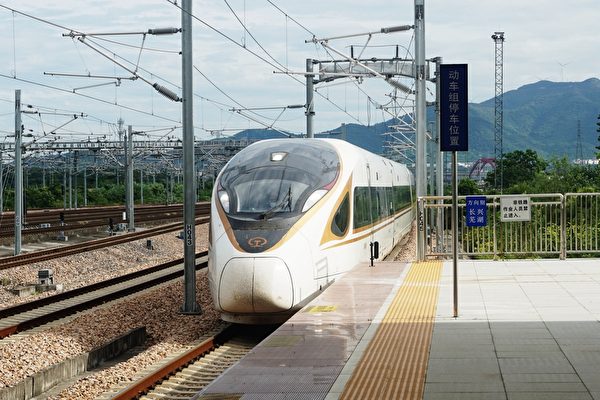China’s high-speed railway ticket price hike has attracted attention from the public, with analysts pointing to a lack of funds as a key reason behind the increase. Out of China’s 45,000 kilometers of high-speed railway lines, only six are profitable.
The China Railway Corporation announced on May 2nd that starting from June 15th, ticket prices for high-speed trains operating at speeds of 300 kilometers per hour and above on several routes will be raised. Some ticket prices will see an increase of nearly 20%, with the business class tickets facing a surge of almost 40%.
Media analysts on the mainland have delved into the reasons behind the high-speed railway ticket price increase. An article by “West City” on May 8th pointed out that the main reason for the price hike is fundamentally due to a financial shortage. There are only six high-speed railway lines in China that are profitable, including Beijing-Shanghai, Shanghai-Nanjing, Nanjing-Hangzhou, Guangzhou-Shenzhen, Beijing-Tianjin, and Shanghai-Hangzhou.
Furthermore, the high-speed railway is burdened with substantial debt. Although in 2023, the high-speed railway finally turned a profit after several years, with a net profit of 3.304 billion yuan, the total debt of the China Railway Group reached a record high of 6.13 trillion yuan. The profit is merely a drop in the bucket compared to the overall debt burden.
According to the think tank “Guval Trend” on May 6th, from 2005 to 2023, the total debt of the China Railway Group skyrocketed from 476.8 billion yuan to 6.13 trillion yuan, a 13-fold increase. In the years 2017-2019, the China Railway issued an average of 300 billion yuan of five-year bonds annually for railway construction, and this year, it still faces a peak period for debt repayment.
Moreover, the operational costs of the high-speed railway, including electricity, labor, maintenance, and general material consumption, continue to rise. “West City” mentioned rumors that the electricity cost for one hour of high-speed rail operation is around 10,000 yuan.
In this scenario, a price hike seems inevitable. It can be expected that this will not be the last time prices are raised. “Guval Trend” stated on May 6th that this price hike is the most significant in the relatively short history of China’s high-speed railway, with a 20% increase in the first and second-class seats, and a nearly 40% increase in business class.
Meanwhile, the Red Star News revealed that after the price hike, some high-speed rail ticket prices have surpassed those of airplane tickets.
On May 7th, the lowest second-class high-speed rail ticket price from Wuhan to Guangzhou South Station (7:25-11:32) was 463.5 yuan, while the lowest airline ticket price from Wuhan Tianhe Airport to Guangzhou Baiyun Airport was just over 300 yuan. In the coming days, the lowest airfare could go as low as under 200 yuan. The second-class high-speed rail ticket from Hangzhou East to Changsha South is priced at 405 yuan, while the lowest flight ticket price from Hangzhou Xiaoshan to Changsha Huanghua Airport in the next few days is not even 300 yuan.
“Guval Trend” analysis indicates that the group most impacted by the high-speed rail price hike are the vast group of migrant workers.
The four high-speed railway routes being adjusted include Shanghai-Hangzhou, Hangzhou-Ningbo, which are short routes situated in the Yangtze River Delta region, one of the most developed areas in China with high per capita income. The other two routes, Wuhan-Guangzhou and Hangzhou-Changzhou, cover multiple provinces such as Hubei, Hunan, Jiangxi, Zhejiang, and Guangdong, with a mix of economically strong provinces and the center of the “Jiangxi economic belt,” showing a significant disparity in economic development levels, leading to varied perceptions of financial changes among individuals.
The central regions of Hunan, Hubei, and Jiangxi are major labor-exporting provinces, along with Jiangxi. Workers from these three central regions need to travel back and forth like migrant birds between economically developed cities like Guangzhou and Hangzhou.
A large portion of the floating population consists of migrant workers, predominantly employed in the construction and manufacturing industries, with limited room for salary increases. In the current environment, it is particularly challenging. In this context, the high-speed rail price hike undoubtedly dampens people’s desire to return home.
Furthermore, migrant workers also need to bear the increasing costs of electricity, water, and other utilities. Some netizens have mentioned that the conventional green train might become a more popular choice for many.

